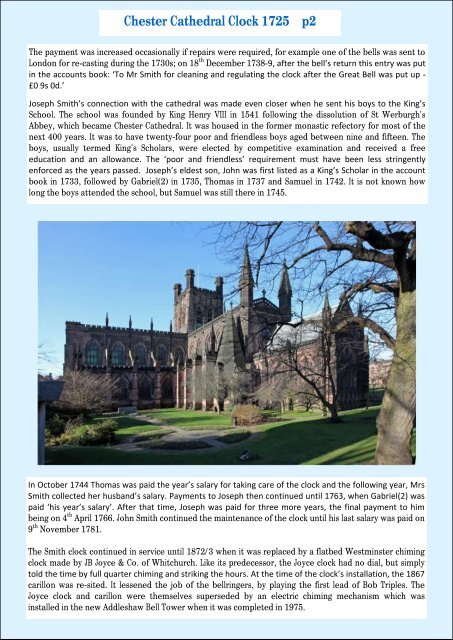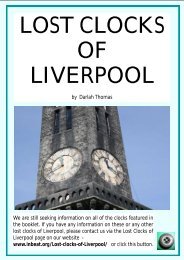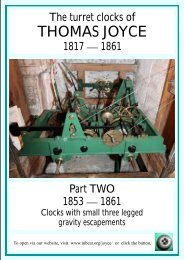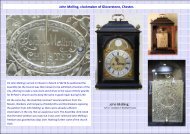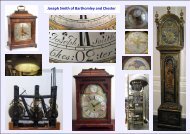Joseph Smiths Turret Clocks
Some images and history on the surviving turret clocks by Joseph Smith
Some images and history on the surviving turret clocks by Joseph Smith
You also want an ePaper? Increase the reach of your titles
YUMPU automatically turns print PDFs into web optimized ePapers that Google loves.
Chester Cathedral Clock 1725 p2<br />
The payment was increased occasionally if repairs were required, for example one of the bells was sent to<br />
London for re-casting during the 1730s; on 18 th December 1738-9, after the bell’s return this entry was put<br />
in the accounts book: ‘To Mr Smith for cleaning and regulating the clock after the Great Bell was put up -<br />
£0 9s 0d.’<br />
<strong>Joseph</strong> Smith’s connection with the cathedral was made even closer when he sent his boys to the King’s<br />
School. The school was founded by King Henry VIII in 1541 following the dissolution of St Werburgh's<br />
Abbey, which became Chester Cathedral. It was housed in the former monastic refectory for most of the<br />
next 400 years. It was to have twenty-four poor and friendless boys aged between nine and fifteen. The<br />
boys, usually termed King's Scholars, were elected by competitive examination and received a free<br />
education and an allowance. The ‘poor and friendless’ requirement must have been less stringently<br />
enforced as the years passed. <strong>Joseph</strong>’s eldest son, John was first listed as a King’s Scholar in the account<br />
book in 1733, followed by Gabriel(2) in 1735, Thomas in 1737 and Samuel in 1742. It is not known how<br />
long the boys attended the school, but Samuel was still there in 1745.<br />
In October 1744 Thomas was paid the year’s salary for taking care of the clock and the following year, Mrs<br />
Smith collected her husband’s salary. Payments to <strong>Joseph</strong> then continued until 1763, when Gabriel(2) was<br />
paid ‘his year’s salary’. After that time, <strong>Joseph</strong> was paid for three more years, the final payment to him<br />
being on 4 th April 1766. John Smith continued the maintenance of the clock until his last salary was paid on<br />
9 th November 1781.<br />
The Smith clock continued in service until 1872/3 when it was replaced by a flatbed Westminster chiming<br />
clock made by JB Joyce & Co. of Whitchurch. Like its predecessor, the Joyce clock had no dial, but simply<br />
told the time by full quarter chiming and striking the hours. At the time of the clock’s installation, the 1867<br />
carillon was re-sited. It lessened the job of the bellringers, by playing the first lead of Bob Triples. The<br />
Joyce clock and carillon were themselves superseded by an electric chiming mechanism which was<br />
installed in the new Addleshaw Bell Tower when it was completed in 1975.


